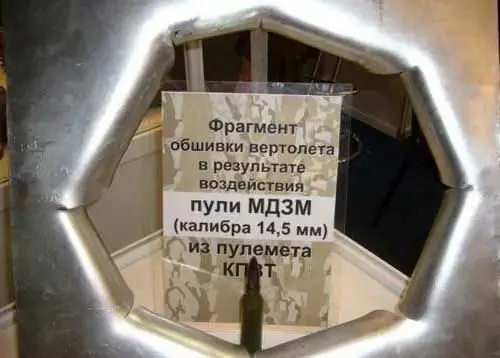2026 Author: Howard Calhoun | [email protected]. Last modified: 2025-01-24 13:10:41
In the first two decades after its appearance, aviation became a formidable fighting force. Naturally, means immediately began to appear to counteract its destructive onslaught. Even the simplest airplanes of the First World War could inflict significant damage on the troops of the opposing sides. Then there was Spain, Abyssinia and many other conflicts that took place with the use of aircraft, bombing often defenseless positions or peaceful villages, without meeting a rebuff. However, massive opposition to aviation began in 1939, when World War II broke out. Air defense artillery has become a separate type of weapon. Most often, the main problem of the ground forces was represented by enemy attack aircraft operating at low altitudes and delivering accurate bombing strikes. This situation has not fundamentally changed over the past seven decades.

Historical background of the Shilka concept
Already at the end of the twenties of the XX century, many arms manufacturers, anticipating the growing demand, began to develop rapid-firing artillery systems, designed primarily forcombat air targets. As a result, samples of small-caliber guns on turret stands, equipped with circular swivel mechanisms, appeared. Examples are the German FlaK anti-aircraft guns (short for Flugzeugabwehrkanone), adopted by the Wehrmacht in 1934. During the war that began five years later, they were repeatedly modernized and produced in huge numbers. The Oerlikons, developed in Switzerland (1927) and used by all warring parties of World War II, gained great fame. The systems showed high efficiency in defeating attack aircraft forced to operate at low altitude. The caliber of these quick-firing guns was usually 20 mm with different lengths of the cartridge (the initial speed and, consequently, the range depend on the volume of explosives in the sleeve). The increase in the rate of fire was achieved by using multi-barreled systems. Thus, a general concept was formed, according to which the Soviet self-propelled anti-aircraft gun "Shilka" was subsequently created.
Why do we need a self-propelled rapid-fire anti-aircraft gun
In the 50s, rocket technology appeared, including anti-aircraft. Strategic bombers and reconnaissance aircraft, which previously felt quite confident in foreign skies, suddenly lost their inaccessibility. Of course, the development of aviation also followed the path of increasing the ceiling and speed, but it became unsafe for ordinary attack aircraft to appear over enemy positions. True, they had one reliable way not to get hit by air defense missiles, and it consisted in entering the target at an extremely low altitude. As of the end of the 60sthe anti-aircraft artillery of the USSR was not ready to repel the attacks of enemy aircraft flying along a flat trajectory at high speed. The response time turned out to be extremely short, a person even with the fastest "boxing" reflexes could not physically have time to open fire, much less hit a target flashing in the sky for a matter of seconds. Automation and reliable detection systems were required. In 1957, a secret decree of the Council of Ministers initiated the start of work on the creation of rapid-fire ZSU. They also came up with a name: the Shilka self-propelled anti-aircraft gun. It was a small matter: to design and manufacture it.

What should ZSU be like?
The requirements for the new technology included many items, among which were many unique to our gunsmiths. Here are some of them:
- Anti-aircraft guns "Shilka" should have a built-in radar to detect hostile aircraft.
- Caliber - 23 mm. Of course, it is small, but the practice of previous military operations showed that with a high rate of fire, an explosive fragmentation charge could well inflict damage sufficient to neutralize the combat capability of an attacking vehicle.
- The system should include an automatic device that generates an algorithm for tracking the target during firing under different conditions, including on the move. Given the elemental base of the middle of the 20th century, the task is not an easy one.
- The Shilka installation must be self-propelled, capable of moving over rough terrain as well as any tank.
Cannons
The artillery of the USSR since Stalin's times was the best in the world, so there were no questions about everything related to the "trunks". It only remained to choose the optimal variant of the charging mechanism (the tape was recognized as the best). Automatic gun 23-mm caliber "Amur" AZP-23 with an impressive "performance" of 3400 rds / min. needed forced liquid cooling (antifreeze or water), but it was worth it. Any target within a radius of 200 m to 2.5 km had little chance of surviving if it hit the crosshairs. The trunks were equipped with a stabilization system, their position was controlled by hydraulic actuators. There were four guns.

Where to put the radar antenna?
ZSU-23 "Shilka" is structurally made according to the classical scheme with a fighting compartment, aft power plant, rear transmission and a mobile turret. Some problems arose with the placement of the radar antenna. It was irrational to place it between the barrels, metal parts could become a screen for emitted and received signals. The lateral position threatened with mechanical destruction of the "plate" from the vibrations that occur during firing. In addition, in conditions of strong electronic countermeasures (interference), a manual control option was provided with aiming through the gunner's sight, and the design of the emitter could block the view. As a result, the antenna was made foldable and placed above the power compartment at the stern.

Motor and chassis
Chassis borrowed from a light tankPT-76. It includes six road wheels on each side. The shock absorbers are torsion bar, the tracks are equipped with rubber seals to protect against premature wear.
Boosted engine (B6R), 280 hp. with., with an ejection cooling system. The transmission is five-speed, providing a range from 30 km / h (on difficult terrain) to 50 km / h (on the highway). Power reserve without refueling - up to 450 km / h with fully filled tanks.
The ZU-23 unit is equipped with a perfect air filtration system, including a labyrinth system of partitions, as well as additional elimination of exhaust gas pollution.
The total weight of the vehicle is 21 tons, including the turret - more than 8 tons.

Instruments
The electronic equipment that the Shilka self-propelled anti-aircraft gun is equipped with is integrated into a single RPK-2M fire control system. The radio instrument complex includes a radar (1RL33M2, assembled on a lamp element base), an on-board computer (at the time of the creation of the sample it was called a calculating device), a radio interference protection system, a backup optical sight.
The complex provides the ability to detect a target (at a distance of up to 20 km), its automatic tracking (up to 15 km), change the carrier frequency of pulses in the event of jamming (wobble), calculate the parameters of fire to achieve a high probability of hitting shells. The system can operate in five modes, including memorizing the coordinates of an object, determining its angle rings and firing at ground targets.
External communication is carried out by radio station R-123M, internal - by intercom TPU-4.

Venerable age and application experience
The Shilka self-propelled anti-aircraft gun was put into service more than half a century ago. Despite such a respectable age for anti-aircraft weapons, four dozen states still have it in the arsenal of their armed forces. The Israeli army, which in 1973 experienced the crushing effect of four barrels of this SZU on its aircraft, continues to use sixty copies captured from Egypt, plus additional ones purchased later. In addition to the republics that previously made up the USSR, many states of Africa, Asia and the Arab world are ready to use Soviet anti-aircraft guns in case of war. Some of them have experience in the combat use of these air defense systems, which managed to make war both in the Middle East and in Vietnam (and by no means against weak opponents). They are also in the armies of the former Warsaw Pact countries, and in considerable numbers. And what is characteristic: nowhere and no one calls the ZU-23 an antique or another nickname that characterizes an outdated weapon.

Modernization and prospects
Yes, the good old Shilka is no longer young. The anti-aircraft gun went through several upgrades aimed at improving performance and increasing reliability. She learned to distinguish her planes from strangers, began to act faster, electronics received new blocks on a modern element base. The last "upgrade" took place in the nineties, at the same time, apparently,the modernization potential of this system has been exhausted. The Shilkas are being replaced by the Tunguskas and other SZUs, which have much more serious capabilities. A modern combat helicopter can hit a ZU-23 from a distance inaccessible to it. What can you do, progress…
Recommended:
Anti-tank mine: specifications. Types and names of anti-tank mines

Anti-tank mine, as its name implies, is used to destroy armored vehicles. The task that the sappers set when installing it is at least to damage the chassis of the tank
How self-tapping screws are made at the factory: technologies and equipment. Machine for the production of self-tapping screws

How are self-tapping screws made at the factory? The answer to this question is a fairly simple technique. At the enterprises, blanks with hats are first made from steel wire. Further, threads are cut on such blanks
Diesel gun: reviews and selection criteria. Diesel gun of indirect heating: technical characteristics

The diesel heat gun is ideal for quickly heating a construction site, agricultural, warehouse or industrial premises. Since its operation is carried out on diesel fuel, it consumes electricity exclusively for the operation of automation and a fan. As the main advantages of such a technological solution, one can name a relatively high thermal power with rather small dimensions
RPK-16 machine gun: specifications. Kalashnikov light machine gun

At the international presentation of weapons "Army-2016", held in September 2016, the RPK-16 machine gun, the brainchild of domestic gunsmiths, was demonstrated. It will be discussed in this article
KPVT, machine gun. Heavy machine gun Vladimirov KPV

The idea of defeating aircraft and lightly armored vehicles led to the creation of heavy machine guns with a caliber of more than 12 mm. Such machine guns were already able to hit a lightly armored target, get a low-flying aircraft or helicopter, as well as shelters behind which there was infantry. According to the classification of small arms, the 14.5-mm KPVT machine gun is already adjacent to artillery weapons. And in design, heavy machine guns have much in common with automatic guns

